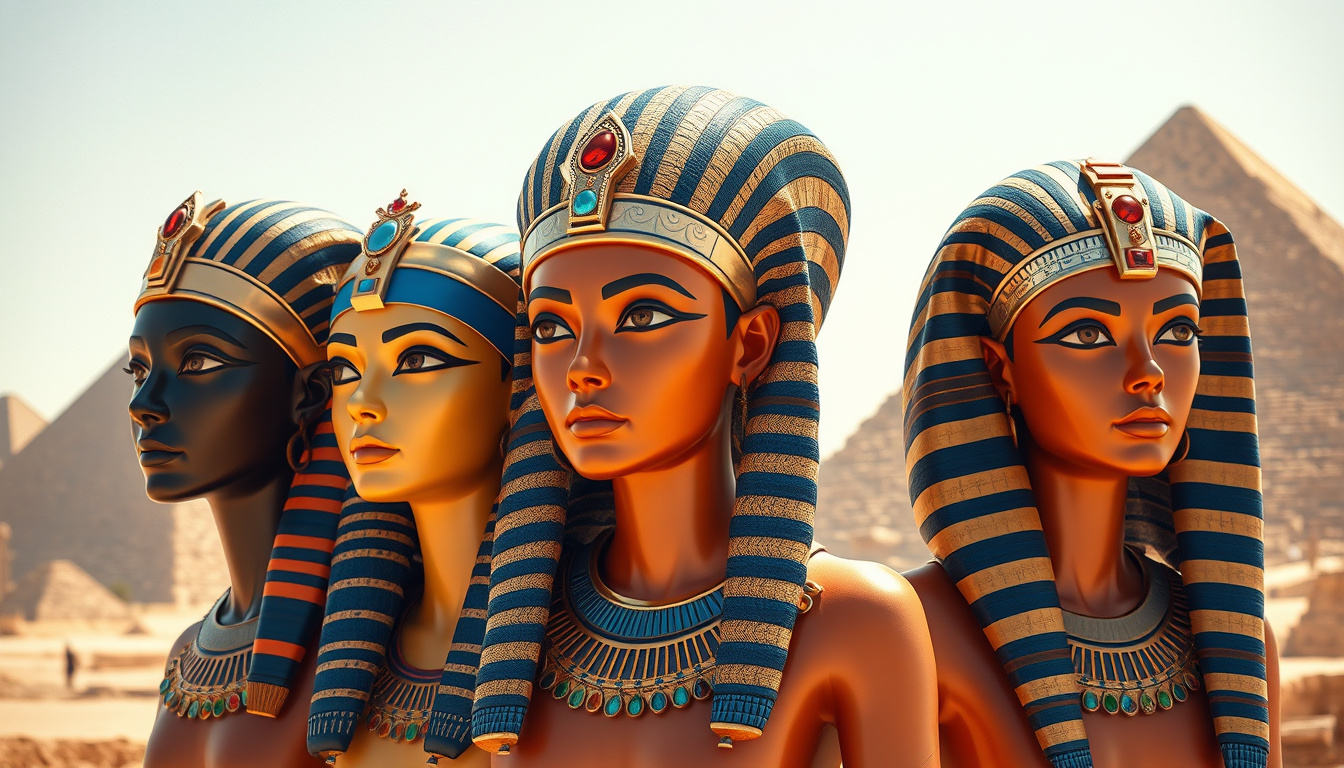When we think of Ancient Egypt, our minds often drift to monumental pyramids, magnificent pharaohs, and the mystique of hieroglyphs.
However, one aspect that is often overlooked yet equally fascinating is the intricate world of Ancient Egyptian wigs.
These ornate accessories were more than just hairpieces—they symbolized power, beauty, and a connection to the divine.
Delving into the significance of Ancient Egyptian wigs reveals a rich tapestry of cultural values revolving around beauty and status that still fascinates us today.


Wigs as Indicators of Social Status
In ancient Egyptian society, wigs were not merely fashionable accessories but profound indicators of social status, wealth, and identity.
The use of ancient Egyptian wigs can be traced back to the earliest periods of Egyptian civilization, where both men and women adorned their heads with these elaborate hairpieces.
Higher-status individuals often sported extravagant, intricately styled wigs made from human hair or plant fibers, embellished with gold and jewels, signifying their elite position within society.
In contrast, commoners typically wore simpler, shorter wigs or none at all, which highlighted the distinct social stratification prevalent in ancient Egypt.
This custom was deeply intertwined with cultural significance, as specific styles could convey age, profession, or even religious devotion, showcasing the essential role of hair in ancient Egyptian identity and social hierarchy.
Beauty Standards in Ancient Egyptian Culture
## Beauty Standards in Ancient Egyptian Culture
When exploring the fascinating world of ancient Egypt, one cannot overlook the allure of beauty standards that shaped the culture.
Among the most striking aspects of these standards were the ancient Egyptian wigs, which were not merely decorative but symbolized status, wealth, and social identity.
Both men and women wore wigs made from a variety of materials, often fashioned from human hair, sheep’s wool, or plant fibers, reflecting a commitment to personal grooming and aesthetics unlike any other in the ancient world.
Wigs in ancient Egypt were more than accessories; they were an integral part of daily life and religious practices.
Typically styled in elaborate designs, wigs could be adorned with beads, flowers, or even gold, showcasing the owner’s wealth and sophistication.
Moreover, the way a wig was worn could communicate significant social cues—for instance, priests might wear distinct styles during ceremonies, while others demonstrated regional affiliations through subtle variations in wig design.
Interestingly, these wigs also had practical benefits.
Egypt’s scorching sun made long hairstyles impractical, prompting many to adopt wigs as a fashionable and cooling alternative.
In addition to their aesthetic and functional roles, ancient Egyptian wigs were also believed to have protective qualities, guarding the wearer against misfortune and bad spirits.
The importance of cleanliness was paramount in ancient Egyptian culture, leading to a fascination with personal hygiene, including the upkeep of wigs.
Evidence shows that wigs were often soaked in scented oils and perfumes, enhancing their appeal and leaving a lasting impression.
Overall, the significance of ancient Egyptian wigs transcended mere vanity; they were a reflection of societal norms, religious beliefs, and individual identity, underscoring the complexity of beauty standards that continue to intrigue historians and cultural enthusiasts today.

The Role of Wigs in Religious and Funerary Practices
### The Role of Wigs in Religious and Funerary Practices
Ancient Egyptian wigs were not merely fashion statements; they held profound significance in both religious and funerary practices.
These elaborate headdresses served as symbols of status and divinity, especially among the elite.
In ancient Egyptian culture, hair played a crucial role as it was seen as a manifestation of vitality and inner strength.
When it came to religious observances, priests often wore wigs that were meticulously crafted from human hair, plant fibers, or sheep’s wool to maintain ritualistic purity and display their connection to the gods.
During funerary practices, wigs also had an essential function.
The ancient Egyptians believed that personal belongings, including wigs, would accompany the deceased into the afterlife.
These wigs, often adorned with intricate decorations, were placed on the mummies to ensure the individuals maintained their identity and status in the next world.
Various depictions in tomb paintings show these wigs being worn by the deceased, serving both as a marker of their life on earth and a means to navigate the complexities of the afterlife.
By understanding the role of ancient Egyptian wigs in these practices, one gains insight into the societal values that shaped their civilizations, revealing the deep connection between appearance, identity, and spirituality.
Frequently Asked Questions
What was the historical significance of wigs in ancient Egypt?
Wigs in ancient Egypt were not only fashion statements but also symbols of social status and beauty.
They reflected the wealth and power of the wearers, and their use was prevalent among both the elite and highly respected individuals.
What materials were ancient Egyptian wigs made from?
Ancient Egyptian wigs were primarily made from human hair, but they also utilized plant fibers and wool.
The techniques included intricate braiding and the incorporation of various adornments to enhance their aesthetic appeal.
How did wigs indicate social status in ancient Egypt?
Wigs were a clear indicator of social status in ancient Egypt.
They were often elaborately designed and adorned with ornaments, and the quality and style of a wig could denote a person’s wealth, occupation, and rank within society.
What were the beauty standards associated with wigs in ancient Egyptian culture?
In ancient Egypt, beauty standards involved a preference for well-groomed hair, often presented through the use of wigs.
Neatness and style in hairstyles were crucial for demonstrating one’s refinement and societal position.
What role did wigs play in religious and funerary practices?
Wigs played a significant role in religious and funerary practices in ancient Egypt.
They were often used by priests during rituals and were included in burial rites to signify status in the afterlife.
Wigs were believed to protect the deceased’s spirit and enhance their beauty in the next world.

